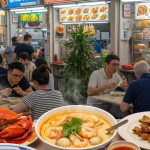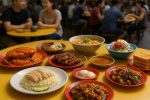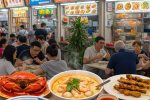Learning how to order kopi like a local is one of the most rewarding experiences for visitors in Singapore. Kopi is not just coffee; it is a ritual woven into everyday life. Ordering it correctly helps you connect with the local rhythm and makes your mornings feel authentic. Yet for many first-time visitors, the kopi ordering system can seem like a puzzle filled with unfamiliar codes, much like navigating Singapore’s hawker culture. With a little guidance, that puzzle turns into a fun and flavorful experience.
Your Quick Look at How to Order Kopi in Singapore
This guide will help you:
- Understand the history and culture behind kopi in Singapore.
- Decode the unique lingo that makes ordering kopi feel like speaking a local language.
- Put together the perfect order based on your taste for milk, sugar, strength, or ice.
- Learn about popular variations beyond the standard cup.
- Pick up insider tips on where and how to enjoy kopi like a true Singaporean.
By the end, you will not only know how to order kopi but also enjoy the culture that makes this drink so special.
Why Ordering Kopi Matters in Singapore
Kopitiams, or traditional coffee shops, are more than places to grab a drink. They are gathering spots where friends meet, families start their day, and workers enjoy a mid-morning break. Ordering kopi correctly shows that you are tuned in to local life, and it often sparks friendly smiles from stall owners. For travelers who want an authentic experience, learning the lingo is like holding a key to Singapore’s cultural heart.
A Quick History of Kopi Culture in Singapore
Kopi has its roots in the early 19th century, when Chinese immigrants roasted coffee beans with sugar and margarine to create a strong, caramel-like flavor. This unique roasting method remains today and is what gives kopi its bold character.
Back then, condensed and evaporated milk were added to balance the strong taste of coffee, as fresh milk was not commonly available. Over time, the mix of robust coffee and creamy sweetness became a staple. The kopitiam grew into a neighborhood institution where people gathered for breakfast, shared stories, and debated current affairs over steaming cups.
Today, kopitiams are still an integral part of Singapore’s food culture. They remain one of the spots to visit at the best hawker centres, while sipping on a cup that carries decades of tradition.
The Basics of Kopi
In Singapore, the word “kopi” simply means coffee, but it is not the same as what you might order at a Western café. Kopi is stronger, thicker, and often sweeter. Beans are roasted with margarine and sugar, ground, and then brewed through a sock-like cloth filter. The result is a drink that packs more punch than drip coffee or espresso.
The default order, if you say just “kopi,” comes with condensed milk and sugar. This is the classic version that locals enjoy for its rich taste and creamy texture. Kopi is widely available at hawker centers, food courts, and traditional kopitiams across the city, often priced at just a fraction of what you’d pay for a latte in a modern café.
Understanding this base cup will make it much easier when you start adding variations to suit your personal taste.
The Kopi Lingo: How to Order Kopi Like a Local
Ordering kopi might feel like learning a new language, but once you know the system, it becomes second nature. Each word in your order tells the stall owner exactly how you want your drink. It’s just like when buying Singapore’s must-try foods that define the country’s everyday dining culture.
The Foundation
The base orders are straightforward. If you say “kopi,” you will get coffee with condensed milk and sugar. Ordering “kopi-O” gives you black coffee with sugar but no milk. “Kopi-C” means coffee with evaporated milk and sugar, producing a less sweet but creamier cup.
Sugar and Sweetness Levels
If you prefer less sugar, you can add “siew dai” to your order, which means “less sweet.” To make it sweeter than usual, say “gah dai.” For a completely sugar-free option, add the word “kosong,” which means empty. So “kopi-O kosong” is black coffee without sugar.
Strength and Concentration
Locals also customize their kopi by adjusting its strength. Saying “gao” makes the coffee stronger, while saying “po” makes it lighter. A “kopi gao” will taste intense and bold, while “kopi po” feels smoother and gentler on the palate.
Temperature and Serving Style
Temperature also changes the experience. Add “peng” if you want your drink iced. A “kopi peng” is perfect for hot afternoons, while a hot kopi warms up breakfast time. If you order takeaway, you might even get your kopi in a tied plastic bag with a straw, a quirky yet very Singaporean touch.
How to Order Kopi Like a Pro: Putting It All Together
The real magic happens when you start combining these codes. For example, if you want coffee with evaporated milk and less sugar, you would say “kopi-C siew dai.” For strong black coffee without sugar, ask for “kopi-O kosong gao.” If you’re looking for a refreshing option, “kopi peng” delivers the sweetness of condensed milk over ice.
It may sound tricky at first, but stall owners are quick to understand, even if your pronunciation is not perfect. Locals often rattle off their orders in seconds, and soon you will be able to do the same.
Common Variations of Kopi and Local Twists
While the standard kopi orders are widely loved, there are also playful variations that locals enjoy. A “kopi cham” blends coffee and tea in one cup, creating a unique taste that balances bitterness with tannins. Yuanyang, a similar mix popular in Hong Kong, is also found in Singapore.
If you prefer chocolate, you can try Milo with your breakfast, often paired with kaya toast. Some stalls even serve Milo Dinosaur, which is a Milo drink topped with extra Milo powder. Modern cafés have also begun reinventing kopi, offering soy milk or oat milk options, making it more inclusive for different diets.
These twists add diversity and fun to the kopi culture, showing how tradition continues to adapt to modern tastes.
Insider Tips for Visitors Wanting to Know How to Order Kopi
For those new to kopi, the best advice is not to worry too much. Stall owners are friendly and will often help if you seem unsure. Watching locals place their orders first can also give you confidence.
The most common way to enjoy kopi is during breakfast, usually with kaya toast and soft-boiled eggs. Another good time is mid-morning, when kopitiams buzz with conversations. Do note that servings are smaller than what you might expect in Western cafés, so don’t be surprised if your cup looks petite.
Also, carry cash, as many traditional stalls do not accept cards. Trying kopi at different locations will give you a sense of how recipes vary slightly from one stall to another.
Where to Try the Best Kopi in Singapore
If you want to start with a familiar environment, you can head to well-known chains like Ya Kun Kaya Toast or Toast Box. These places are easy to find and consistent in quality. For a more traditional feel, visit Killiney Kopitiam or Tong Ah Eating House, both of which have long histories and strong reputations.
Each location offers something different. Chains give you a modern, air-conditioned experience, while older kopitiams allow you to soak in a nostalgic atmosphere with marble tables and wooden stools. Trying both lets you appreciate the range of kopi culture in Singapore.
The Cultural Experience Beyond the Cup
Drinking kopi is not just about the beverage but also about the experience that surrounds it. Kopitiams are social spaces where people gather, read newspapers, and discuss daily news. Observing the culture can be as enjoyable as drinking the kopi itself.
A well-known part of kopitiam etiquette is the tissue packet practice. Locals leave a small packet of tissues on the table to reserve their seat, a habit called “chope-ing.” Another unspoken rule is to clear your tray after finishing your meal, keeping the space clean for the next customer.
Ordering kopi using the right lingo makes you feel part of this environment. It turns an ordinary drink into a meaningful cultural connection.
How to Order Kopi and Enjoy Singapore Like a Local
Understanding how to order kopi gives your time in Singapore an authentic touch. It is a small step that carries a big impact, giving you confidence to interact with locals and enjoy an everyday ritual. While many visitors head straight for Singapore attractions like the best rooftop bars, taking time for a simple kopi in a hawker center lets you see another side of the city.
So the next time you visit, try saying your order with confidence. A warm smile and a perfectly brewed cup of kopi will remind you that the best way to understand Singapore is often found in its simplest traditions.








